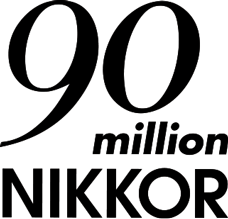Total Production of NIKKOR Lenses for Interchangeable Lens Cameras Reaches 90 Million
November 4, 2014
TOKYO - Nikon Corporation is pleased to announce that total production of NIKKOR lenses*1 for Nikon interchangeable lens cameras reached ninety million at the end of October 2014. Moreover, total production of NIKKOR lenses equipped with the Silent Wave Motor (SWM), the autofocus motor developed exclusively by Nikon, reached fifty million.
- *1Interchangeable lenses for Nikon SLR cameras and Nikon 1, Advanced Cameras with Interchangeable Lenses

In 1959, Nikon (then Nippon Kogaku K.K.) released the Nikon F as well as its first NIKKOR lenses for Nikon SLR cameras, including the NIKKOR-S Auto 5cm f/2. The NIKKOR tradition has continued over the many years since those first lenses were released.
Nikon continues to actively release new NIKKOR lenses utilizing the advanced optical technologies cultivated over its long history, and to expand its lineup of interchangeable lenses for Nikon 1, Advanced Cameras with Interchangeable lenses, the first of which was released in October 2011. Total production of NIKKOR lenses reached eighty-five million in January 2014 with production continuing at a steady rate since.
In addition, total production of NIKKOR lenses equipped with the Silent Wave Motor (SWM), the autofocus motor developed by Nikon, has reached fifty million.
Nikon's SWM converts "traveling waves" into rotational energy to focus the optics, which achieves extremely quiet autofocus photography. In just eighteen years since the 1996 release of the Ai AF-S Nikkor 300mm f/2.8D IF-ED, one of the first lenses for which the SWM was adopted, total production of NIKKOR lenses equipped with the SWM has reached fifty million. To date, a total of 72*2 zoom lenses, fixed focal length (prime) lenses, and Micro lenses covering a broad range of focal lengths, from ultra wide-angle to super telephoto, equipped with the SWM have been released for FX- and DX-format digital SLR cameras.
In addition, one*2 fast, medium-telephoto, fixed focal length (prime) lens equipped with the SWM has been released for Nikon's Advanced Cameras with Interchangeable Lenses.
All NIKKOR lenses for SLR cameras released since 2004 have been equipped with the SWM*3.
- *2The total number of NIKKOR lenses equipped with the SWM currently available (as of November 4, 2014).
- *3Does not include PC-E lenses.
Among the most recent products for which the SWM was adopted is the AF-S NIKKOR 400mm f/2.8E FL ED VR, released in August 2014. This lens, compatible with Nikon FX-format digital SLR cameras, represents a new generation of high-performance super-telephoto lenses with which a significantly lighter weight has been achieved.
In addition, Nikon responded to a variety of user needs in September 2014 by adding the ultra wide-angle AF-S NIKKOR 20mm f/1.8G ED to its lineup of fast, f/1.8 fixed focal length (prime) lenses for Nikon FX-format cameras. Naturally, the AF-S NIKKOR 20mm f/1.8G ED utilizes the latest optical design technologies to achieve superior resolution. What's more, adoption of Nikon's Nano Crystal Coat lens coating controls generation of flare and ghost, and adoption of ED lens elements achieves superior rendering capability with little chromatic aberration. The lens is extremely portable due to its compact size and light weight, and it makes photographic expression utilizing a wide angle and beautiful blur characteristics possible.
In June 2014, Nikon released the 1 NIKKOR VR 70-300mm f/4.5-5.6 for Nikon 1, Advanced Camera with Interchangeable Lenses. This super-telephoto zoom lens with a maximum focal length equivalent to 810mm (equivalent in 35mm format), is the world's smallest and lightest*4 lens in its class. The current lineup of 1 NIKKOR lenses consists of twelve lenses with focal lengths ranging from 6.7mm to 300mm (angles of view equivalent to 18mm to 810mm in 35mm [135] format) for coverage of a broad range of focal lengths, from ultra wide-angle to super-telephoto.
- *4Among interchangeable lenses with a focal length that exceeds the equivalent of 600mm in 35mm [135] format for digital still cameras equipped with autofocus functions available as of March 13, 2014. Comparison of the minimum volume with each lens. Statement based on Nikon research.
The NIKKOR brand
NIKKOR is Nikon's brand of photographic lenses. The NIKKOR name arose from adding "r"—a common practice in the naming of photographic lenses at the time the name was established—to "Nikko", the Romanized abbreviation for Nippon Kogaku K.K., the original name used when the company was established.
Nikon's own high-quality standards are applied to all stages from initial design and development to final product release for design that responds to user needs, and production system and inspections that ensure the superior quality of NIKKOR lenses.
Nikon's lineup of lenses for cameras with interchangeable lenses currently consists of more than 90 types of lenses, including ultra wide-angle to super-telephoto lenses, fisheye lenses, zoom lenses, Micro lenses, and PC-E lenses that support a wide variety of applications, as well as 1 NIKKOR lenses for Advanced Camera with Interchangeable lenses.
In 2013, Nikon celebrated the 80th anniversary of NIKKOR lenses with a variety of activities conveying the advantages of NIKKOR lenses, under the theme of "ART meets TECHNOLOGY makes HISTORY including creation of the "Eyes of Nikon" photo collection, and cooperation in the creation of "Masters of the Light", a collection of artistic photographs captured with NIKKOR lenses. The celebration continued in 2014 with the Eyes of Nikon Photo Exhibition held at Nikon Plaza Shanghai.
The information is current as of the date of publication. It is subject to change without notice.
